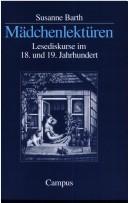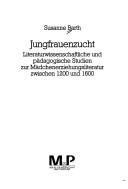| Listing 1 - 10 of 11 | << page >> |
Sort by
|

ISBN: 3593370379 Year: 2002 Publisher: Frankfurt am Main ; New York, NY : Campus Verlag,
Abstract | Keywords | Export | Availability | Bookmark
 Loading...
Loading...Choose an application
- Reference Manager
- EndNote
- RefWorks (Direct export to RefWorks)
Geschiedenis van opvoeding en onderwijs --- handboeken en inleidingen --- handboeken en inleidingen. --- Handboeken en inleidingen. --- FEMMES DANS LA LITTERATURE --- FEMMES --- EDUCATION --- ALLEMAGNE --- HISTOIRE --- LIVRES ET LECTURE --- 18E SIECLE --- 19E SIECLE
Book
ISBN: 9783161563034 3161563034 9783161589508 Year: 2021 Volume: 122 122 Publisher: Tübingen Mohr Siebeck
Abstract | Keywords | Export | Availability | Bookmark
 Loading...
Loading...Choose an application
- Reference Manager
- EndNote
- RefWorks (Direct export to RefWorks)
"Die christliche Nächstenliebe ist ein zentraler Aspekt im Werk Gregors des Großen. Durch die Analyse seines Gesamtwerks zeigt Susanne Barth, wie stark der römische Bischof sowohl sein theologisches Denken als auch sein kirchenleitendes Handeln am Nutzen für den Mitmenschen ausrichtet."
Charity --- 276 =71 GREGORIUS I MAGNUS --- 276 =71 GREGORIUS I MAGNUS Latijnse patrologie--GREGORIUS I MAGNUS --- 276 =71 GREGORIUS I MAGNUS Patrologie latine--GREGORIUS I MAGNUS --- Latijnse patrologie--GREGORIUS I MAGNUS --- Patrologie latine--GREGORIUS I MAGNUS --- Theological virtues --- Religious aspects --- Christianity --- Gregory --- Gregorius --- Grégoire --- Grégoire, --- Gregor, --- Gregorio, --- Grēgorios --- Gregorius, --- Gregory,

ISBN: 3476450449 Year: 1994 Publisher: Stuttgart M & P
Abstract | Keywords | Export | Availability | Bookmark
 Loading...
Loading...Choose an application
- Reference Manager
- EndNote
- RefWorks (Direct export to RefWorks)
Book
Year: 1987 Publisher: Tübingen
Abstract | Keywords | Export | Availability | Bookmark
 Loading...
Loading...Choose an application
- Reference Manager
- EndNote
- RefWorks (Direct export to RefWorks)
Book
ISBN: 1612499562 1612499570 Year: 2024 Publisher: West Lafayette, IN : Purdue University Press,
Abstract | Keywords | Export | Availability | Bookmark
 Loading...
Loading...Choose an application
- Reference Manager
- EndNote
- RefWorks (Direct export to RefWorks)
Digital
ISBN: 9789400745551 Year: 2013 Publisher: Dordrecht Springer Netherlands
Abstract | Keywords | Export | Availability | Bookmark
 Loading...
Loading...Choose an application
- Reference Manager
- EndNote
- RefWorks (Direct export to RefWorks)
Grasslands cover a significant proportion of the land mass of the world, and play a pivotal role in global food production. At the same time we are faced with several challenges that affect the way in which we think about this valuable set of resources. The population of the world is expected to exceed 9 billion by 2050, and increase of about one third relative to today’s levels. This population increase will be focused in urban areas, and in what are currently viewed as “developing” countries, meaning that the buying power of this increased population will be greater – shifting the balance of demand from staple crops to high value items such as meat and dairy products. Overall that the world will have to approximately double agricultural output across all categories of food to meet the demands of this larger, urbanised population. This is occurring against a backdrop of equally large challenges in terms of global climate change. Agriculture is already a significant contributor to e.g. greenhouse gas emissions, deforestation and soil erosion. The situation is made more complex by an increased emphasis on biofuels as a solution for our imminent oil shortage, resulting in increased competition between land utilised for food and fuel. In short, agriculture must continue to feed the world, whilst not contributing to damaging it further. It must be sustainable. Plant breeding plays a significant but frequently understated role in meeting the challenges presented by this complex and changing scenario. However, plant breeding and improvement is itself undergoing radical change driven by technology. This book explores how forage and turf breeding is changing and adapting to meet these challenges using the technological advances being experienced in plant breeding as a whole.
Biology --- Plant physiology. Plant biophysics --- Botany --- Agriculture. Animal husbandry. Hunting. Fishery --- Biotechnology --- systematische plantkunde --- biobrandstoffen --- biologie --- bevolking --- landbouw --- biotechnologie --- duurzame ontwikkeling --- botanie --- klimaatverandering
Book
ISBN: 9400745540 9401782105 9786613946249 9400745559 1283633795 Year: 2012 Publisher: Dordrecht : Springer,
Abstract | Keywords | Export | Availability | Bookmark
 Loading...
Loading...Choose an application
- Reference Manager
- EndNote
- RefWorks (Direct export to RefWorks)
Grasslands cover a significant proportion of the land mass of the world, and play a pivotal role in global food production. At the same time we are faced with several challenges that affect the way in which we think about this valuable set of resources. The population of the world is expected to exceed 9 billion by 2050, and increase of about one third relative to today’s levels. This population increase will be focused in urban areas, and in what are currently viewed as “developing” countries, meaning that the buying power of this increased population will be greater – shifting the balance of demand from staple crops to high value items such as meat and dairy products. Overall that the world will have to approximately double agricultural output across all categories of food to meet the demands of this larger, urbanised population. This is occurring against a backdrop of equally large challenges in terms of global climate change. Agriculture is already a significant contributor to e.g. greenhouse gas emissions, deforestation and soil erosion. The situation is made more complex by an increased emphasis on biofuels as a solution for our imminent oil shortage, resulting in increased competition between land utilised for food and fuel. In short, agriculture must continue to feed the world, whilst not contributing to damaging it further. It must be sustainable. Plant breeding plays a significant but frequently understated role in meeting the challenges presented by this complex and changing scenario. However, plant breeding and improvement is itself undergoing radical change driven by technology. This book explores how forage and turf breeding is changing and adapting to meet these challenges using the technological advances being experienced in plant breeding as a whole.
Agriculture. --- Crop improvement -- Congresses. --- Forage plants -- Breeding -- Congresses. --- Grasses -- Breeding -- Congresses. --- Forage plants --- Turfgrasses --- Agriculture --- Earth & Environmental Sciences --- Plant Sciences --- Agriculture - General --- Breeding --- Agricultural biotechnology. --- Plant breeding. --- Agro-biotechnology --- Life sciences. --- Plant science. --- Botany. --- Plant genetics. --- Life Sciences. --- Plant Breeding/Biotechnology. --- Plant Genetics & Genomics. --- Plant Sciences. --- Crops --- Biotechnology --- Plant Genetics and Genomics. --- Farming --- Husbandry --- Industrial arts --- Life sciences --- Food supply --- Land use, Rural --- Botanical science --- Phytobiology --- Phytography --- Phytology --- Plant biology --- Plant science --- Biology --- Natural history --- Plants --- Genetics --- Floristic botany
Year: 1988 Publisher: Keulen Kunst- und Museumbibliothek, Reinischen Bildarchiv
Abstract | Keywords | Export | Availability | Bookmark
 Loading...
Loading...Choose an application
- Reference Manager
- EndNote
- RefWorks (Direct export to RefWorks)
Book
Year: 1993 Publisher: [Lieu de publication inconnu]: [éditeur inconnu],
Abstract | Keywords | Export | Availability | Bookmark
 Loading...
Loading...Choose an application
- Reference Manager
- EndNote
- RefWorks (Direct export to RefWorks)
Book
ISBN: 3319445294 3319445308 Year: 2016 Publisher: Cham : Springer International Publishing : Imprint: Springer,
Abstract | Keywords | Export | Availability | Bookmark
 Loading...
Loading...Choose an application
- Reference Manager
- EndNote
- RefWorks (Direct export to RefWorks)
This book presents a flavour of activities focussed on the need for sustainably produced biomass to support European strategic objectives for the developing bioeconomy. The chapters cover five broad topic areas relating to the use of perennial biomass crops in Europe. These are: ‘Bioenergy Resources from Perennial Crops in Europe’, ‘European Regional Examples for the Use of Perennial Crops for Bioenergy’, ‘Genotypic Selection of Perennial Biomass Crops for Crop Improvement’, ‘Ecophysiology of Perennial Biomass Crops’ and ‘Examples of End-Use of Perennial Biomass Crops’. Two major issues relating to the future use of biomass energy are the identification of the most suitable second generation biomass crops and the need to utilise land not under intensive agricultural production, broadly referred to as ‘marginal land’. The two main categories of plants that fit these needs are perennial rhizomatous grasses and trees that can be coppiced. The overarching questions that are addressed in the book relate to the suitability of perennial crops for providing feedstocks for a European bioeconomy and the need to exploit environments for biomass crops which do not compete with food crops. Bioenergy is the subject of a wide range of national and European policy measures. New developments covered are, for example, the use of perennial grasses to produce protein for animal feed and concepts to use perennial biomass crops to mitigate carbon emissions through soil carbon sequestration. Several chapters also show how prudent selection of suitable genotypes and breeding are essential to develop high yielding and sustainable second generation biomass crops which are adapted to a wide range of unfavourable conditions like chilling and freezing, drought, flooding and salinity. The final chapters also emphasise the need to be kept an eye out for potential new end-uses of perennial biomass crops that will contribute further to the developing bioeconomy.
Life sciences. --- Climate change. --- Agriculture. --- Plant breeding. --- Life Sciences. --- Climate Change/Climate Change Impacts. --- Plant Breeding/Biotechnology. --- Biomass energy. --- Agriculture and energy. --- Energy crops --- Risk assessment. --- Environmental aspects. --- Biomass crops --- Biomass energy crops --- Energy farming --- Fuel crops --- Energy and agriculture --- Energy in agriculture --- Bio-energy (Biomass energy) --- Bioenergy (Biomass energy) --- Biofuels --- Biological fuels --- Energy, Biomass --- Microbial energy conversion --- Agriculture --- Agriculture and energy --- Crops --- Field crops --- Forests and forestry --- Fuel --- Biomass energy --- Power resources --- Renewable energy sources --- Energy conversion --- Microbial fuel cells --- Refuse as fuel --- Waste products as fuel --- Breeding --- Farming --- Husbandry --- Industrial arts --- Life sciences --- Food supply --- Land use, Rural --- Changes, Climatic --- Changes in climate --- Climate change --- Climate change science --- Climate changes --- Climate variations --- Climatic change --- Climatic changes --- Climatic fluctuations --- Climatic variations --- Global climate changes --- Global climatic changes --- Climatology --- Climate change mitigation --- Teleconnections (Climatology) --- Environmental aspects --- Global environmental change
| Listing 1 - 10 of 11 | << page >> |
Sort by
|

 Search
Search Feedback
Feedback About UniCat
About UniCat  Help
Help News
News